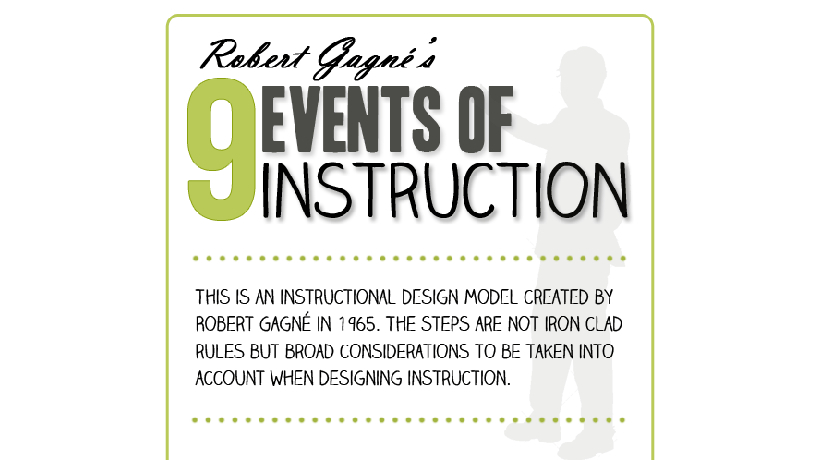Applying 9 Events Of Instruction In eLearning: Creating eLearning With Time-Tested Learning Theories
Over the last decade, eLearning has grown as the preferred means of learning worldwide – both in education as well as the corporate world. This popularity and success is due to the evident fact that eLearning is more cost effective and convenient, while increasing opportunities for perineal learning – a definite need for the modern corporate learner today. eLearning has several advantages over traditional learning, especially when coupled with technology-aided delivery which opens up the opportunity of learning anytime and anywhere. Learners can access online course material, irrespective of time and place. For adult learners, reflection is a huge part of learning, which encourages assimilation of information – turning it into knowledge which they can apply at work. eLearning allows learners to reflect on the learning materials and their responses, and permits them to work at their own pace, regardless of race, sex, disability, or appearance. A number of learning theories can be applied in eLearning, and developers have to choose the one that suits the needs of their learners as well as align well to the strength of a technology-aided medium. The application of Gagné’s 9 Events of Instruction in eLearning lists the following events of instruction:
- Gaining the learner’s attention.
- Informing the learner of the objectives.
- Stimulating recall of prior learning.
- Presenting the learning stimulus.
- Providing learning guidance.
- Eliciting appropriate performance.
- Providing feedback.
- Assessing learner performance.
- Enhancing retention and transfer.
While applying these steps it is possible to create eLearning that is cognizant of the latest technology that is also grounded in sound instructional design which produces desired learning as well as performance outcomes.
Here are some ways of aligning time tested ways of applying 9 Events of Instruction in eLearning and create online courses that work!
1. Gain The Learner’s Attention
There are many ways of gaining attention of the learner. The eLearning platform is also ideal for reflection and speculation. With this in mind, grabbing learner attention will definitely lead to retaining it – if the impact is sound enough.
- Ask a question.
This is often how an instructor begins his or her lecture. Why not use it for eLearning as well? A question instantly opens up the mind and the learner gets ready to think and proceed. - Present a problem.
This too puts the learner in the right frame of mind, where he or she can analyse the problem, think about a solution and its consequences. - Share a new situation.
An emotional connection is always strong and situations or scenarios make sure they obtain the learners' attention by inviting them to empathize.
2. Inform The Learners Of The Objective
Adult learners are most comfortable when they feel in charge of their own learning. They are perceptive of their needs and feel more inclined to learn when they know ‘why’ they are going ahead with it. Sharing the objectives of learning thus allows the learners to organize their thoughts. eLearning courses thus can define and share objectives at the very beginning to make sure that the foundation of learning is well laid.
3. Stimulate Recall Of Prior Knowledge
This allows learners build on their previous knowledge or skills. Although we are capable of acquiring our creative moments, it is much easier to build on what we already know.
- eCourses can include a short capsule of prior knowledge relevant to the current lesson and provide the learners with a framework that aids learning and remembering.
- This capsule can be a short learning nugget in itself which helps all learners to be at the same level before the actual learning material is shared.
- Multi-media can be adopted for this – making sure that the recall process is not wholly text-driven and tedious.
4. Present The Material
This is the most important part of learning delivery – the very crux of any learning course. There are various ways of going forward with this. However, it’s wise to keep certain tenets in mind.
- It is important to logically compartmentalize the information to avoid memory overload.
- Shorter chunks of information are better consumed as well as retained.
- Blend the information with relief elements like images, audio or even video elements to provide and retain interest.
5. Provide Guidance For Learning
In addition to the learning content, it is important to provide instruction on how to learn. This is normally simpler and easier than the subject matter or content.
- A different channel or media can be utilized to create a support for learning to avoid mixing it with the subject matter. This can be a fact capsule or short summary after each topic which allows learners to take a breadth, assimilate and make sure that they’ve understood the information well
- The rate of learning increases with the addition of such guides because learners are less likely to waste of time or become frustrated by basing performance on incorrect facts or poorly understood concepts.
6. Elicit Performance
eCourses should continually allow the learner to practice the newly acquired behavior, skills, or knowledge.
- Interactivities can be made part of the eCourse to make sure that the learners have the opportunity to get more involved with the eContent.
- The 2D or 3D diagram can be made interactive through simple animation and text. As the learner moves the mouse through different parts of the diagram, they pop up and spring to life.
- Instead of simple text explanations, the different sections can be explained through animations (like fade-in/fade-out) and audio.
7. Provide Feedback
It is not just enough to ask questions, it is also necessary to share and comment on learner's response and analyze learner's behavior.
- Feedback needs to be specific, not general, as in "You are doing a good job".
- Tell them ‘why’ they are doing a good job or provide specific guidance.
8. Assess Performance
Tests can be included in the e-course to determine if the lesson has been learned. This can also provide general progress information.
- Online tests are usually designed through adaptive testing. The adaptive testing requires a series of tests or a question bank. When a learner wants to take up an assessment, he or she can register with name, course ID and password. Test items are then displayed on screen and the learner is required to take up the entire test online by punching in the answers – on a laptop, desktop computer, tablet, or even a smartphone.
- This is very efficient way of tapping the ability of the learner. Easy test items appear first in order to check the level of learner’s ability.
- The level is increased as learner goes through each test successfully.
9. Enhance Retention And Transfer
Enhance retention by making sure that impact of the learning course is not limited to the time consuming it.
- Mobile platform is especially suitable for creating an avenue for training support as the learner can access it wherever and whenever he feels the need to learn.
- Learning re-enforcements like checklists, short videos and audio clips can be made available to sustain training through elements which align very well on the mobile platform and can be made use of – even when on the move.
The 9 events of instruction can be successfully applied to eLearning – shared above are only some of the many ways of doing so. Learning theories form the base for creating content which is effective – this is true for newer platforms of learning delivery as well. Adopting and applying tried and tested theories can certainly increase the effectiveness of the learning content.








